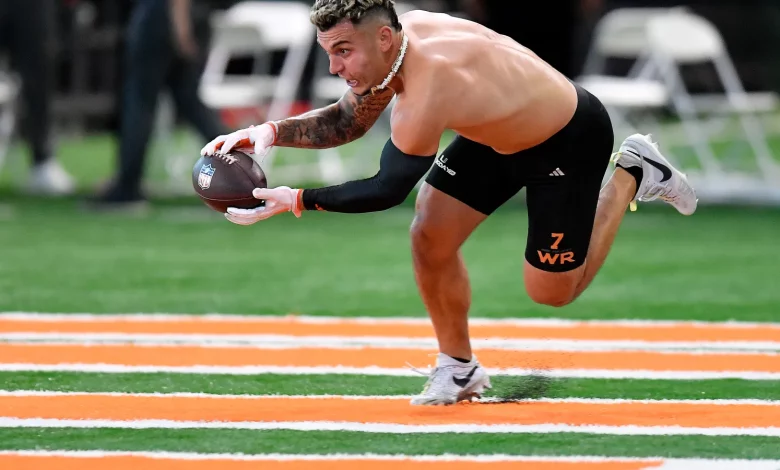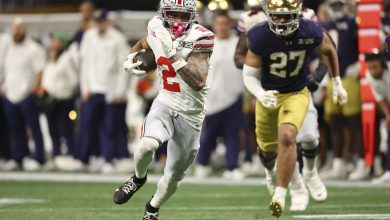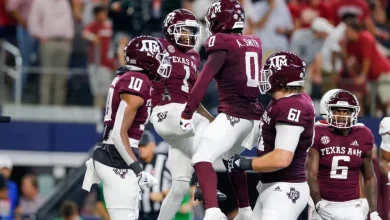Miami wide receiver Xavier Restrepo Explains His Unknown Slow 40 Time on Pro Day

Miami Wide Receiver Xavier Restrepo Explains His Unknown Slow 40 Time on Pro Day
On Pro Day, a day that often shapes the future of many aspiring NFL players, one name that unexpectedly raised some eyebrows was Miami Hurricanes wide receiver Xavier Restrepo. Despite being one of the more productive and versatile receivers for the Hurricanes over the past few seasons, Restrepo’s 40-yard dash time didn’t quite match the expectations set by his on-field performances. Known for his quickness, agility, and ability to make plays in critical moments, Restrepo’s 40-yard time at Pro Day—clocked slower than anticipated—became a point of discussion. Yet, in an exclusive interview after the event, Restrepo shed light on why his 40 time didn’t reflect his true capabilities and how he felt about his performance overall.
This article dives deep into Restrepo’s explanation, the nuances of his athletic abilities that don’t show up in a simple 40-yard dash, and why his Pro Day experience shouldn’t define his future in the NFL. It also looks at the bigger picture surrounding Pro Day performances and how they often fail to represent the full scope of a player’s potential. Furthermore, we’ll analyze Restrepo’s journey from Miami’s depth chart to one of the most reliable targets in the passing game and why the 40-yard dash may not tell the full story of his abilities as a wide receiver.
Xavier Restrepo: A Closer Look at the Player
Before delving into his Pro Day performance, it’s essential to understand who Xavier Restrepo is as a player. Over the past few seasons at Miami, Restrepo has developed a reputation for being a dependable, high-energy wide receiver. His ability to run crisp routes, make key catches in critical situations, and act as a safety valve for quarterbacks made him one of the most reliable targets in Miami’s offense.
Restrepo is known for his excellent understanding of the game, an innate ability to get open, and a tenacious work ethic that has earned him respect both from his teammates and coaches. Standing at 5’10” and weighing in around 190 pounds, he may not have the prototypical size that some NFL teams covet for a wide receiver, but his skill set and football IQ more than make up for it. He has been a key player for the Hurricanes since his freshman year, and his production has steadily grown. Restrepo’s strength lies in his sharp route running, excellent hands, and the ability to find space in tight coverage.
While he’s not considered one of the absolute fastest wide receivers, he makes up for it with quickness, separation in short areas, and the agility to avoid tacklers once the ball is in his hands. His ability to change direction in the blink of an eye, coupled with his strong hands, made him a fan favorite in Miami and a player who excelled in both the slot and on the outside.
Pro Day: The Importance and Pressure
For players like Restrepo, Pro Day serves as a critical opportunity to prove their worth to NFL scouts, general managers, and coaches. It’s a moment where they can showcase their skills, improve on numbers from the NFL Combine, and make a final impression before the draft. For some players, Pro Day is their last chance to impress NFL teams who might have been less impressed by Combine results or game tape. For others, it can be a chance to solidify their place as a potential early-round pick.
Every drill—from the 40-yard dash to the three-cone drill to the shuttle runs—serves as a way for NFL teams to gauge an athlete’s raw physical potential. But it’s also about showcasing a player’s overall fitness, agility, and ability to perform under pressure. As much as Pro Day is about athleticism, it’s also a day of immense pressure. For players hoping to make an impression, a less-than-ideal time in a key drill like the 40-yard dash can be a setback, even if it doesn’t define their overall skill set.
For a player like Restrepo, the 40-yard dash time was one of the key metrics scouts were focusing on. Speed is one of the most prized attributes for wide receivers in today’s NFL, and the 40-yard dash has become a staple of any evaluation. However, as Restrepo would soon explain, this single drill doesn’t encapsulate everything he brings to the table as a wide receiver.
The Unexpected Slow 40 Time: Restrepo’s Explanation
When the results of Restrepo’s 40-yard dash were released, many were surprised by the time. The clock had him running in the range of 4.65 to 4.7 seconds—significantly slower than many had expected given his ability to separate from defenders on the field. In his post-Pro Day interview, Restrepo addressed the issue candidly, offering insights that helped explain why his 40 time didn’t reflect his true abilities as a football player.
“I know it wasn’t the time people were expecting, but there’s more to my game than just straight-line speed,” Restrepo said. “It’s a lot about how you get off the line, how you adjust to different situations on the field, and how you use your quickness and agility in the game. A 40-yard dash is just one part of it, but it’s not the full story.”
For Restrepo, the 40-yard dash represents a single moment in a larger body of work. While he recognizes the importance of speed in certain situations, he believes that his strengths lie in other areas—areas that are not captured in a straight-line sprint. In fact, Restrepo pointed out that many of his biggest plays during his career at Miami came in situations where his burst off the line or his ability to change direction in tight spaces was far more valuable than simply being fast in a straight line.
Restrepo’s Real Strengths: Agility, Quickness, and Technique
As Restrepo correctly pointed out, his skill set revolves around agility and quickness rather than just top-end speed. His ability to change direction and stop on a dime allows him to create separation from defenders without needing to outrun them in a race. In fact, he’s often been more effective in short-yardage situations, where his precise route running and understanding of defensive coverage have been his greatest assets.
Restrepo’s quickness in and out of breaks allows him to separate from defenders in the middle of the field, often turning a short reception into a much larger gain after the catch. In college football, particularly in the slot, his ability to create mismatches with defenders has been one of his defining traits. This type of quickness and change of direction is often more valuable than top-end speed in today’s NFL, where defenses prioritize quick, fluid route runners who can gain separation through technique and skill rather than just speed.
Moreover, Restrepo’s ability to track the ball, catch passes in tight windows, and make contested catches has made him a reliable option for quarterbacks. His strong hands, mental toughness, and the ability to gain yardage after the catch are all critical components of his game. These attributes, combined with his football IQ and leadership, are what make him a desirable NFL prospect despite not having the fastest 40 time.
The 40-Yard Dash: A Limited Measure
Restrepo’s situation underscores a broader issue with how the 40-yard dash is often overemphasized in evaluations of wide receivers. The reality is that this one drill only measures a small portion of what makes a wide receiver effective on the field. Speed is certainly an asset, but as Restrepo pointed out, it is not the only attribute that defines a player’s value.
Many successful NFL wide receivers have posted relatively average 40 times. For instance, legendary receivers such as Jerry Rice (4.7) and Anquan Boldin (4.7) were not known for blazing 40-yard dash times, yet their on-field performances were consistently among the best in the league. These players excelled because of their ability to read defenses, run precise routes, and create separation using their body control and football intelligence.
NFL teams are increasingly looking at a broader set of attributes beyond just speed, including route running, catching ability, and the ability to read the game. These are the skills that allow wide receivers to thrive in real-game scenarios, where athleticism in a straight-line sprint may be less important than being able to beat a defender in the middle of a route or make a tough catch in a contested situation.
Restrepo’s Future: The Importance of Versatility and Character
Despite his slower-than-expected 40 time, Xavier Restrepo’s future remains bright. His versatility as a wide receiver, his ability to play both inside and outside, and his exceptional work ethic will serve him well as he transitions to the NFL. Teams are looking for players who can contribute in a variety of ways, and Restrepo’s ability to make plays both in the passing game and after the catch is something that sets him apart.
Additionally, his leadership and character off the field are qualities that NFL teams value immensely. Coaches and general managers look for players who have the right mindset, a strong work ethic, and a commitment to continuous improvement. Restrepo embodies all of these traits, and they will undoubtedly play a significant role in his success at the next level.









